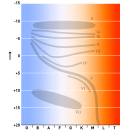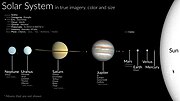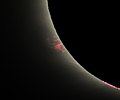 | A chromosphere ("sphere of color") is the second layer of a star's atmosphere, located above the photosphere and below the solar transition region and... 12 KB (1,304 words) - 15:09, 11 April 2024 |
 | known as solar prominences or filaments. The Sun's corona lies above the chromosphere and extends millions of kilometres into outer space. Coronal light is... 62 KB (7,681 words) - 04:04, 2 May 2024 |
 | absorption lines. It is called the chromosphere from the Greek root chroma, meaning color, because the chromosphere is visible as a colored flash at the... 164 KB (18,531 words) - 09:29, 12 May 2024 |
 | known as a fibril or mottle, is a dynamic jet of plasma in the Sun's chromosphere about 300 km in diameter. They move upwards with speeds between 15 and... 4 KB (480 words) - 11:23, 5 January 2024 |
 | magnetic field, lie in the photosphere. Above the photosphere lies the chromosphere. This part of the atmosphere first cools down and then starts to heat... 7 KB (818 words) - 16:16, 5 January 2024 |
with armor that enables survival in volcanic environments or even the chromosphere of a star for short periods of time. When a group of Autobots (and Chip... 363 KB (2,338 words) - 17:05, 6 May 2024 |
 | chromosphere (the Greek chrōma meaning "color") appears. Though the reddish hydrogen radiation is most visible to the unaided eye, the chromosphere also... 10 KB (1,178 words) - 04:02, 2 May 2024 |
 | A plage /pleɪdʒ/ is a bright region in the Sun's chromosphere, typically found in and around active regions. Historically, they have been referred to as... 4 KB (387 words) - 00:53, 29 April 2024 |
 | seen through filters. The Sun's faint corona will be visible, and the chromosphere, solar prominences, coronal streamers and possibly even a solar flare... 84 KB (9,734 words) - 02:45, 28 April 2024 |
 | lowest level of the atmosphere, just above the photosphere, is the thin chromosphere region, where spicules appear and stellar flares begin. Above this is... 146 KB (16,321 words) - 04:24, 9 May 2024 |
 | evidence of a hot chromosphere above the photosphere of red giants, where investigating the heating mechanisms for the chromospheres to form requires 3D... 26 KB (3,361 words) - 11:58, 24 April 2024 |
 | Lockyer, is credited with discovering the gaseous nature of the solar chromosphere, and with some justification the element helium. Janssen was born in... 13 KB (1,376 words) - 19:00, 21 March 2024 |
 | features in the Sun's atmosphere, including solar prominences and the chromosphere. According to the Bohr model of the atom, electrons exist in quantized... 7 KB (856 words) - 14:17, 7 April 2024 |
Microturbulence Oscillations Radiation zone Atmosphere Photosphere Starspot Chromosphere Stellar corona Alfvén surface Stellar wind Bubble Bipolar outflow Accretion... 103 KB (2,126 words) - 16:22, 3 May 2024 |
 | and Edward Frankland, as it was first observed in the spectrum of the chromosphere of the Sun. Helium makes up for about 25% of the Sun's mass. Helius is... 307 KB (33,994 words) - 04:01, 4 May 2024 |
 | illustration of the structure of the Sun Granules Sunspot Photosphere Chromosphere Convection zone Radiation zone Tachocline Solar core Solar corona Flare... 55 KB (6,599 words) - 12:47, 14 May 2024 |














